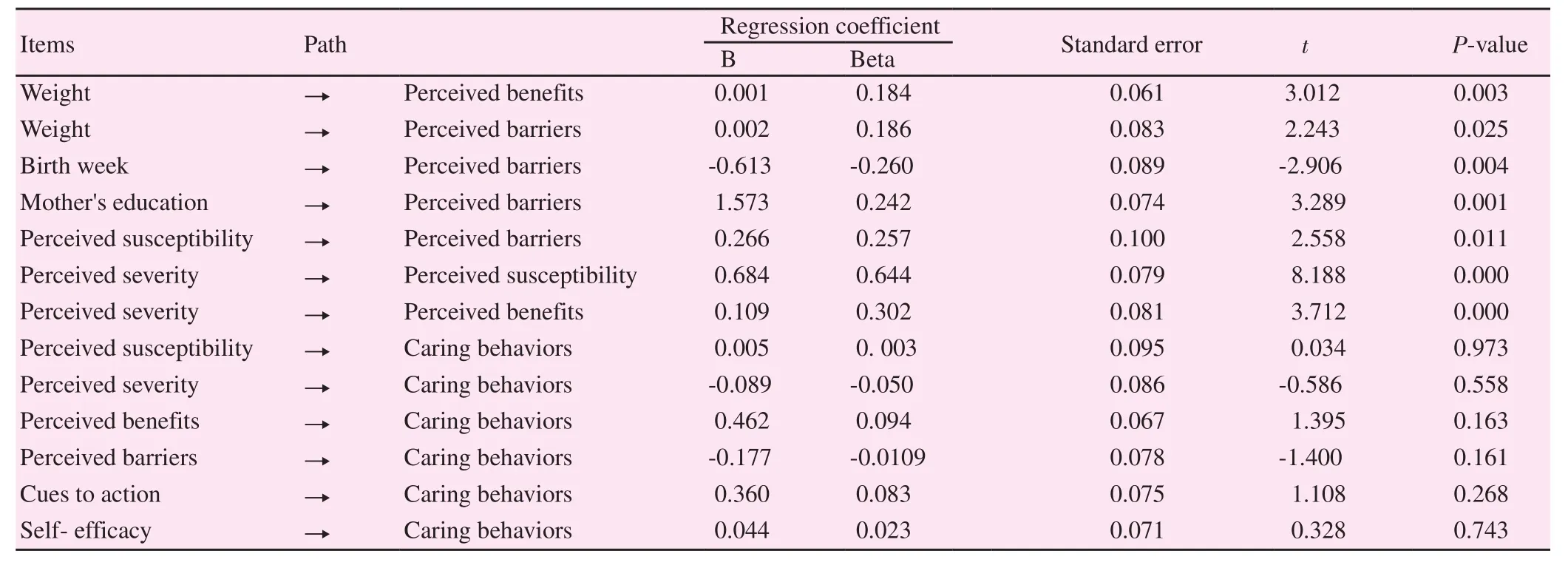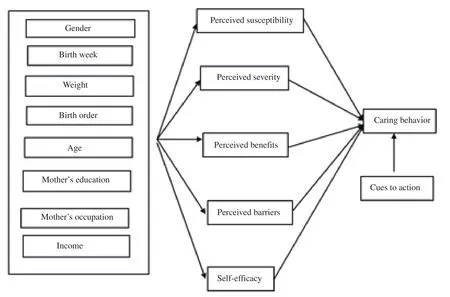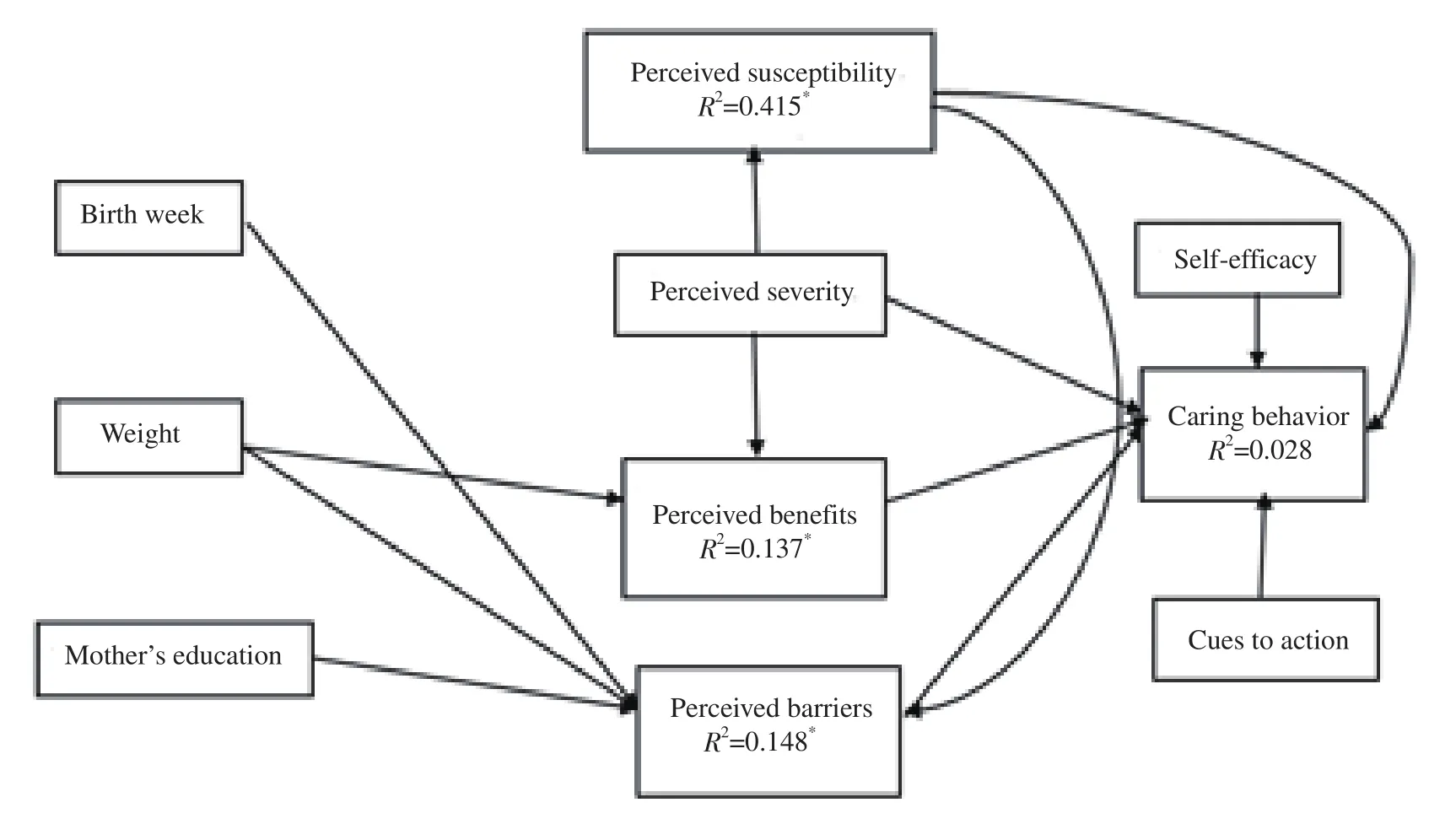Predictors of caring behaviors of mothers of premature infants based on the health belief model
Roghayeh Ghomi, Parvaneh Vasli, Meimanat Hosseini
Department of Nursing, School of Nursing and Midwifery, Shahid Beheshti University of Medical Sciences, Tehran, Iran
ABSTRACT
KEYWORDS: Health belief model; Structural equation modeling; Premature infant; Mother; Care
1.Introduction
Preterm labor is the most important cause of infant mortality[1]and it refers to the delivery before the 37th week of pregnancy[2].Fifteen million premature infants are annually born around the world[3].However, these infants are at the high risk of adverse effects such as the sudden infant death syndrome, a low neural recovery, and respiratory infection after the discharge.Promoting the home health care can reduce these risks and improve complications[4].Therefore,taking care of these infants not only involves physicians, nurses and healthcare workers, but also families and, in particular, mothers[5].Parents, especially mothers, are not psychologically prepared for parental roles[6].Parents’ separation from infants and its resulting stress also have a negative effect on parental role and the continuity of relationship between parents and infants[7], causing the parents’loss of self-esteem[8].Therefore, families feel incapacitated and have little control over their infant conditions[9].These conditions cause incompetence in parental roles and affect the child development[10].Therefore, mothers of premature infants are likely to face more challenges in caring[11].Accordingly, the health care system pays attention to families of premature infants and how they care about their birth and stay in the neonatal intensive care unit until the discharge and caring at home[12].It is essential to use models for identification of behavior determinants.The health belief model(HBM) is a model for predicting the behaviors[13].Constructs of this model are the perceived susceptibility (individual perception of the risk of disease), perceived severity (individual perception of the seriousness of disease complications), perceived benefits (individual perception of positive consequences of a behavior), perceived barriers (individual perception of obstacles to a behavior), cues to action (internal and external cues that determine the individual readiness for action), and the self-efficacy (individual confidence in the ability to adopt a behavior).As one of the most important behavior change models, the HBM seeks to explain and predict the health behavior.This model is based on people’s motivation for the health action and believes that changing beliefs leads to the behavioral change[14].Various studies used the HBM to predict factors affecting various health behavior including cognitive factors that determine the preventive behavior of diabetes in high risk groups[15], determinants of the self-care behavior in women with type 2 diabetes[16], and the breast self-examination in the Iranian women[17].Considering that the postpartum period is a critical stage for mothers and infants[18], and parents and in particular mothers are responsible for taking care of infants after the discharge[19], it is helpful to investigate factors which can affect the caring behavior of mothers of premature infants at home, in planning to improve maternal caring behavior.
The present study aims to investigate predictive factors of caring behavior in mothers of premature infants by the HBM.
2.Materials and methods
2.1.Study design
The present study was descriptive-analytical and conducted by using the structural equation modeling from October 2017 to February 2018.In this study, HBM constructs were considered as independent variables and caring behaviors of mothers of premature infants as dependent variable.Operational definitions of HBM constructs were as follows: a) Perceived susceptibility: Mothers’perception of risk of improper care consequences; b) Perceived severity: Mothers’ severity of perception of improper infant care consequences; c) Perceived benefits: Benefits that are perceived by mothers for taking care of infants; d) Perceived barriers: Barriers that prevent mothers from taking proper care; e) Cues to actions: Internal(individual) and external (interpersonal) cues that guided mothers to care for premature infants; f) Self-efficacy: Mothers’ confidence in their abilities to perform caring behavior; and g) Caring behaviors:Mothers’ behavior in care for premature infants.
2.2.Setting and participants
The structural equation modeling (structural equation modeling included a diverse set of mathematical models, computer algorithms,and statistical methods that fit networks of constructs to data.Structural equation modeling included confirmatory factor analysis,confirmatory composite analysis, path analysis, partial least squares path modeling, and latent growth modeling) considered 10 to 20 participants per independent variable[20].The present study considered 15 variables including 8 variables related to demographic characteristics (infant age, infant gender, infant weight, birth order,mother’s education and occupation, and income, and Father’s education) and 6 variables of HBM constructs as the independent variables, and mothers’ caring behavior as the dependent variable.Twelve participants were considered for each independent variable,and thus the research was conducted on 168 mothers of premature infants.
Mothers of premature infants in the neonatal intensive care unit were included in the research by the convenience sampling method.Inclusion criteria for mothers were as follows: aged over 17; literacy;willingness to participate in the study; lack of mental illness;birth before 37 weeks of pregnancy; birth in the studied hospital:Akbarabadi Hospital; singleton pregnancy; no risk of intrauterine growth restriction or any congenital disorder or malformation; and starting the breastfeeding.
2.3.Instruments
Data were collected by using a HBM-based researcher-made questionnaire, the standard self-efficacy questionnaire and the maternal caring behaviors checklist.The researcher-made questionnaire consisted of the following sections: demographic characteristics with 22 terms including the perceived susceptibility with 6 terms; perceived severity with 5 terms; perceived benefits with 5 terms; perceived barriers with 6 terms; and cues to action with 6 terms.This questionnaire was designed based on the latest available references for the care of premature infants and according to HBM constructs; and its content was studied and prepared by members of the research team.For the first four choices, answers were on a fivepoint Likert scale from “totally agree” to “totally disagree” and the score ranged from one to five.The score ranges of these four choices were 6-30; 5-25; 5-25; 6-30, respectively.For cues to action, answers were ranked according to four options from “never” to “high” with a score range of one to four.The score range of this construct was 6-24.Bandura’s standard 10-term tool was used to measure the selfefficacy.In this questionnaire, the responses were on a four-point Likert scale from “totally correct” to “totally incorrect” with a score range of one to four.In the whole of questionnaires, all terms were directly scored.The maternal caring behaviors checklist, which consisted of 35 terms, had the following sections: Kangaroo care with 10 terms; diapers with 8 terms; breast milk with 9 terms; and setting the temperature with 8 terms.Responses to checklist terms were according to “do not perform right”, “perform quite right”, and“do not perform quite right” with scores from zero to two.The score range of this construct was 0-70.
Apart from Bandura’s standard self-efficacy questionnaire, which has been used and confirmed in various Persian studies[13,15-17],the HBM-based questionnaire and the checklist on maternal caring behaviors were given to 10 experts including 1 pediatricians, 5 pediatrician sub-specialists, and 4 faculty members of college of nursing and midwifery to investigate questionnaires in terms of the content validity, the content validity ratio (CVR) , and the content validity index (CVI).The content validity ratio results confirmed the need for all questions.The content validity index of 0.92 also approved the relevance of all questions to objectives.To determine the reliability, questionnaires were given to 20 mothers of premature infants who were not later included in the study.Cronbach’s alpha was obtained from 0.74 to 0.96 for different sections of the HBM-based questionnaire.The reliability of caring behaviors checklist for mothers of premature infants was evaluated and obtained equal to 0.92 through the coefficient of agreement between supervisors.
2.4.Data collection and analysis
Data collection was done in a step.All questionnaires were selfreport and completed by participants.The caring behavior checklist was completed by the first researcher and after observing mothers’performance in taking care of premature infants.Data were analyzed by using SPSS Version 16.0 for Windows (SPSS Inc., Chicago, IL,USA).Pearson correlation coefficient was used to determine the correlation between HBM constructs and caring behaviors.The structural equation modeling was used to verify the correlation between HBM constructs with each other and caring behaviors of mothers of premature infants.Two models were extracted.We consideredχ2/df from 3 to 5, comparative fit index (CFI) above 0.90,root mean square error of approximation (RMSEA) from 0.08 to 0.10, and the standardized root mean squared residual (SRMR) less than 0.05 as acceptable values of fit indices[21].
2.5.Ethical statement
The study was approved by the Institutional Review Board of Shahid Beheshti University of Medical Sciences (IR.SBMU.PHNM.1395.641) with written consent prior to data collection.All necessary licenses were obtained to enter the study environment.Prior to inclusion of mothers, research objective, confidentiality of information and the right to withdraw freely from the study were explained to them and they signed the informed consent for participation in the study.
3.Results
3.1.Participants’ characteristics
Based on the research findings, the infant age was from 26 to 36 weeks, with a mean age (32.70±2.57) weeks.Infants were from 700 g to 3 800 g, with a mean weight (646.09±12.20) g.The mothers’age were (28.88±5.99) years.Most of mothers (45.2%) had high school education and were housewife (93.5%) (Table 1).
3.2.Matrix correlation
The mean and standard deviation of variables were shown in Table 2.Among HBM constructs, the mean of caring behaviors was most different from maximal values.There was a significant correlation between perceived severity and perceived susceptibility(r=0.64, P=0.001), perceived benefits and perceived susceptibility(r=0.29, P=0.001), perceived benefits and perceived severity (r=0.32,P=0.001), perceived barriers and perceived susceptibility (r=0.24,P=0.001), cues to action and perceived susceptibility (r=0.26,P=0.001), cues to action and perceived benefits (r=0.22, P=0.001),self-efficacy and perceived benefits (r=0.24, P=0.001) and caring behaviors and cues to action (r=0.08) (Table 3).In general, two constructs, namely the perceived severity and perceived susceptibility had a good correlation.

Table 4.Standardized and non-standardized regression coefficients, t and P-values of model 2 (modified).

Figure 1.Structural equation modeling of model 1 (initial health belief model).

Figure 2.Structural equation modeling of model 2 (modified health belief model).Symbol * refers to significance of the results.
3.3.Structural equation modeling
According to indices in the present population, the initial HBM(model 1) did not have a good fit (Figure 1: relativeχ2= 6.22,CFI=0.273, RMSEA=0.176, and SRMR=0.087.In the next step,changes were made in locations of constructs in order to achieve the goodness, and finally we confirmed the fit of model 2 that was the modified form of model 1 (Figure 2; relativeχ2= 2.10, CFI=0.862,RMSEA=0.081, and SRMR=0.05).Table 4 and Figure 2 indicated that there was a significant relationship between some variables of demographic characteristics with HBM constructs in model 2.Accordingly, it for one unit increase in the infant weight, 0.001 was added to perceived benefits (P=0.003).Furthermore, for one unit increase in the infant weight and mother’s education, 0.002 and 1.573 were respectively added to perceived barriers (P=0.025 and P=0.001, respectively), and for one unit increase in the birth week,0.613 was reduced from perceived barriers (P=0.004).In total,14.8% of variance of perceived barriers was expressed by the infant weight, birth week, mother’s education.
A number of constructs also had significant positive correlation with each other, so that for one unit increase in the perceived susceptibility, 0.266 was added to perceived barriers (P=0.011);and for one unit in the perceived severity, 0.684 was added to the perceived susceptibility (P<0.001) and 0.109 to perceived benefits(P<0.001).Approximately 41.5% of the perceived susceptibility variance was expressed by the perceived severity.Furthermore,13.7% of variance of perceived benefits could be predicted by the perceived severity and infant weight.None of constructs of model 2 had a significant positive correlation with the caring behavior of mothers of premature infants, and only 2.8% of caring behavior variance of mothers was expressed by the sum of demographic characteristics and HBM constructs.
4.Discussion
Results of the structural equation modeling indicated that initial HBM constructs (model 1) in mothers of premature infants did not have a good fit.The fit of model 2, which was a modified model 1,was confirmed by changing locations of constructs.However, less than 3% of caring behaviors of mothers of premature infants could be predicted by HBM constructs including perceived severity, perceived susceptibility, perceived benefits, perceived barriers, cues to action and self-efficacy and demographic characteristics, and almost none of HBM constructs had a significant positive relationship with the caring behaviors of mothers of premature infants.Despite the fact that some demographic characteristics such as the infant weight,birth weight, and mother’s education had a significant relationship with perceived benefits and perceived barriers, the predictive value of these constructs by demographic characteristics was less than 15%.In other words, demographic characteristics played negligible roles in predicting HBM constructs.
The results of this study showed that the HBM predicted caring behaviors of mothers of premature infants very poorly (less that 3%).This finding is not consistent with other studies.The Karimy et al found that 59.9% of the variance of self-care behavior predicted with self-efficacy, perceived barrier, benefit and susceptibility.The result of another study indicated that 51.0% of the variance in intention to seek psychological help can be predicated by the HBM variables[22].Yue et al found 50.5% of the variance in antihypertensive medication adherence based on HBM.Higher levels of perceived susceptibility, cues to action, and self-efficacy and a lower level of perceived barriers were significantly associated with better anti-hypertensive medication adherence[23].Also, in the study of Dehghani-Tafti et al, HBM constructs predicted 33.5% of the variance of self-care behaviors[24].In another study, HBM factors accounted for 11.0% of the total variance in health-promoting behaviors[25].
In the present study, the reason for the lack of positive and significant correlation between the HBM constructs and caring behaviors in mothers of premature infants were perhaps the mothers’lack of enough knowledge about the risk of improper care of premature infants and its consequences, the stressful conditions of infants and the neonatal intensive care unit, the inaccurate communication of some health care providers with mothers and inadequate mothers’ encouragement and training for proper care.
However, the present study was unique and important in terms of two aspects.First, based on the authors’ search it was the first time that predictors of caring behaviors in mothers of premature infants were studied based on HBM.The use of HBM was helpful in identifying determinants of behavior and determining how these factors work[26].Second, the structural equation modeling was used for a closer examination of relationships between constructs.Structural equation modeling allowed modeling and testing relationships of multiple variables, and thus it was a preferred method for verifying theoretical models[20].
In conclusions, according to the research findings, none of HBM constructs including the perceived susceptibility, perceived severity,perceived benefits, perceived barriers, self-efficacy and cues to action could predict the caring behaviors of mothers of premature infants.The most important limitations of this study included mothers’fatigue and boredom to complete questionnaires.Despite conducting this study on mothers of premature infants in Iran, its results can be generalized to other health care sectors and countries.
Conflict of interest statement
The authors declare no conflict of interest.
Acknowledgments
The authors express their gratitude and appreciation to the mothers who participated in the study.Our gratitude should be extended to authorities and managers of the Akbarabadi Hospital for their cooperation with this study.
Authors’ contributions
Roghayeh Ghomi and Parvaneh Vasli conducted the conception of the study, drafted the article and made the interpretation of data.Meimanat Hosseini was responsible for the acquisition of data and analysis.Parvaneh Vasli carried out the ethical procedure.
 Asian Pacific Journal of Reproduction2020年5期
Asian Pacific Journal of Reproduction2020年5期
- Asian Pacific Journal of Reproduction的其它文章
- Possible links between COVID-19 and male fertility
- Protective and therapeutic effect of protocatechuic acid in assessment of letrozoleinduced polycystic ovary syndrome in rats
- Semen collection methods and cooling rates affect post-thaw sperm motility and kinematic parameters of Saanen goat
- Identification of stable internal control genes for accurate normalization of real-time quantitative PCR data in testicular tissue from two breeds of cattle
